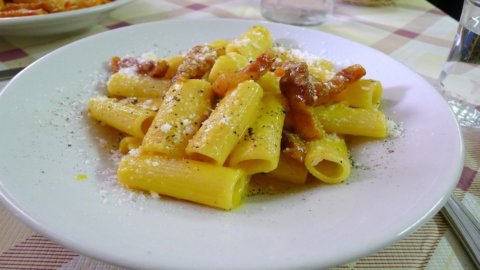Horror, a piece of news is shaking the waters of the restaurant world and of the purists of Italian cuisine. On the authoritative pages of the New York Times one came out tomato carbonara recipe. One of the most famous dishes in the world of Italian cuisine, is proposed in the pages of the American newspaper aimed at gourmand readers and dedicated to cooking suggestions such as “Smoky Tomato Carbonara”, or smoked tomato carbonara. This wasn't enough, the version invented by the US newspaper uses the tomato as well as the bacon instead of bacon while the Pecorino Romano is replaced by Parmesan a bad copy Made in the USA of Parmigiano Reggiano and Grana Padano.
We are in full ethical food counterfeiting of a symbol of Made in Italy but also physical of our food and wine heritage. A heritage that is desecrated all over the world by imitations and counterfeits with a damage that Coldiretti values overall at 100 billion euros, with the United States in first place.
Carbonara - adds Coldiretti - figure among the most scarred Italian recipes abroad with, for example, the habit of modifying it with the use of cream without pecorino. But among the most "betrayed" specialties there are also the typical caprese served with industrial cheese instead of buffalo mozzarella or fiordilatte, while there are also cases of pasta with pesto proposed with almonds, walnuts or pistachios instead of pine nuts and with the common cheese that replaces the ever-present Parmigiano Reggiano and pecorino romano.
On the ingredient of tomatoes in the carbonara, the US newspaper admits that "they are not traditional in the carbonara, but they give a brilliant flavor to the dish". For the preparation of the creamy sauce, on the other hand, he recommends making it when the raw eggs are seasoned with the hot pasta, away from direct heat to avoid coagulated eggs. E' points out that the procedure can be complicated, but the method used is foolproof. In particular, it is recommended to add a little hot cooking water for the pasta to the beaten eggs and to season the mixture of tempered eggs in the pasta, stirring vigorously to then have a smooth and glossy sauce.
This obviously makes gourmets shiver, even if it doesn't have history on its side, Carbonara still has an all-Italian typicality.
According to an entirely Abruzzo hypothesis, the dish would have been "invented" by the charcoal burners (carbonari in Roman dialect) in the L'Aquila area, who prepared it using ingredients that were easy to find and keep. In fact, to make the charcoal it was necessary to supervise the charcoal pit for a long time and therefore it was important to have the necessary supplies with you.
Carbonara in this case would be the evolution of the dish called cacio e ova (Cace e Ove, in Abruzzo dialect), of Abruzzo origins, which the Carbonari used to prepare the day before by carrying it in their "tascapane" and which they ate with their hands.
Pepper was already used in large quantities for the preservation of bacon, fat or lard used to replace oil, which was too expensive for charcoal burners.
More likely, the most accredited hypothesis refers to more recent times, the invention of this dish would have Lazio origins. Certainly carbonara is not mentioned in the classic Roman cooking manual by Ada Boni, published in 1930. Vice versa it is traced back to the period immediately following the liberation of Rome in 1944, when bacon brought by allied troops appeared in the Roman markets.
According to this thesis, during the Second World War the American soldiers who arrived in Italy combined to prepare food the most familiar ingredients they had available, i.e. powdered eggs and bacon with which they gave flavor to spaghetti. The cooks of taverns and restaurants had the idea at this point of ordering and calibrating the ingredients and above all the flavor with pancetta or guanciale (here there are two schools of thought) instead of bacon, and pecorino, in a recipe that will develop and become famous later.
But even if the Americans can boast some merit in the birth of Carbonara this does not authorize them to disfigure it with tomato, moreover smoked.





